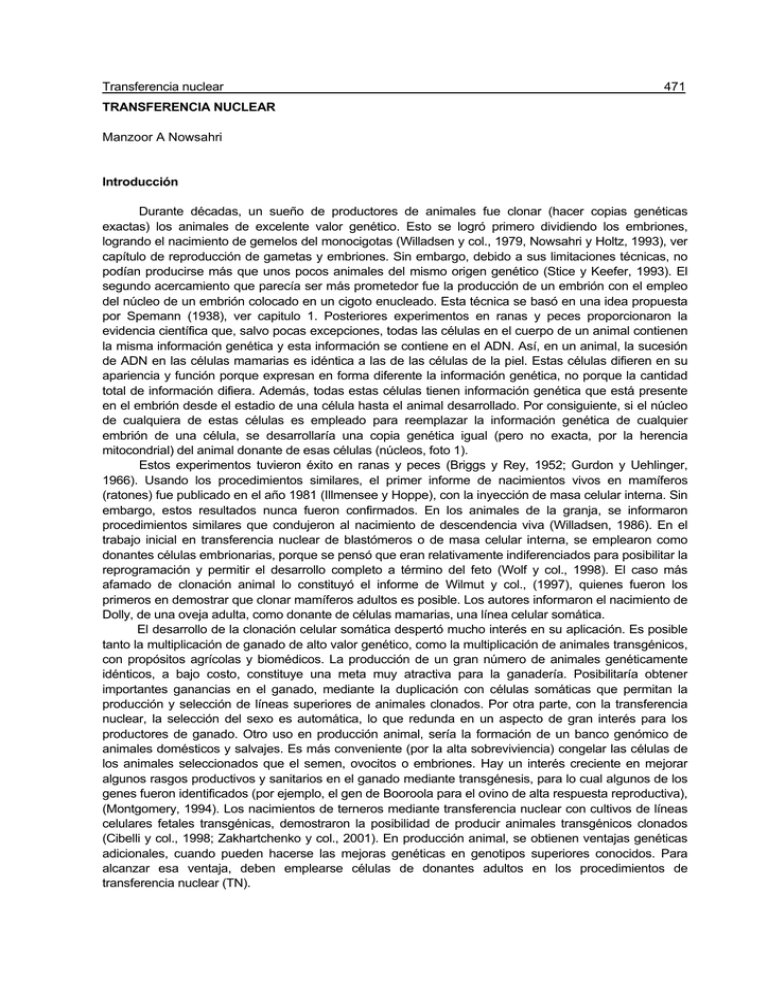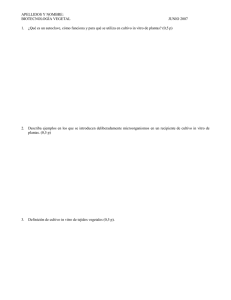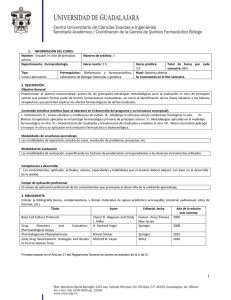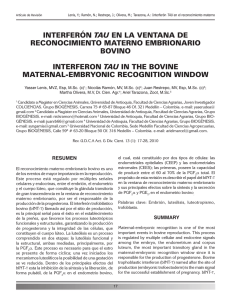Transferencia nuclear 471 TRANSFERENCIA
Anuncio

Transferencia nuclear 471 TRANSFERENCIA NUCLEAR Manzoor A Nowsahri Introducción Durante décadas, un sueño de productores de animales fue clonar (hacer copias genéticas exactas) los animales de excelente valor genético. Esto se logró primero dividiendo los embriones, logrando el nacimiento de gemelos del monocigotas (Willadsen y col., 1979, Nowsahri y Holtz, 1993), ver capítulo de reproducción de gametas y embriones. Sin embargo, debido a sus limitaciones técnicas, no podían producirse más que unos pocos animales del mismo origen genético (Stice y Keefer, 1993). El segundo acercamiento que parecía ser más prometedor fue la producción de un embrión con el empleo del núcleo de un embrión colocado en un cigoto enucleado. Esta técnica se basó en una idea propuesta por Spemann (1938), ver capitulo 1. Posteriores experimentos en ranas y peces proporcionaron la evidencia científica que, salvo pocas excepciones, todas las células en el cuerpo de un animal contienen la misma información genética y esta información se contiene en el ADN. Así, en un animal, la sucesión de ADN en las células mamarias es idéntica a las de las células de la piel. Estas células difieren en su apariencia y función porque expresan en forma diferente la información genética, no porque la cantidad total de información difiera. Además, todas estas células tienen información genética que está presente en el embrión desde el estadio de una célula hasta el animal desarrollado. Por consiguiente, si el núcleo de cualquiera de estas células es empleado para reemplazar la información genética de cualquier embrión de una célula, se desarrollaría una copia genética igual (pero no exacta, por la herencia mitocondrial) del animal donante de esas células (núcleos, foto 1). Estos experimentos tuvieron éxito en ranas y peces (Briggs y Rey, 1952; Gurdon y Uehlinger, 1966). Usando los procedimientos similares, el primer informe de nacimientos vivos en mamíferos (ratones) fue publicado en el año 1981 (Illmensee y Hoppe), con la inyección de masa celular interna. Sin embargo, estos resultados nunca fueron confirmados. En los animales de la granja, se informaron procedimientos similares que condujeron al nacimiento de descendencia viva (Willadsen, 1986). En el trabajo inicial en transferencia nuclear de blastómeros o de masa celular interna, se emplearon como donantes células embrionarias, porque se pensó que eran relativamente indiferenciados para posibilitar la reprogramación y permitir el desarrollo completo a término del feto (Wolf y col., 1998). El caso más afamado de clonación animal lo constituyó el informe de Wilmut y col., (1997), quienes fueron los primeros en demostrar que clonar mamíferos adultos es posible. Los autores informaron el nacimiento de Dolly, de una oveja adulta, como donante de células mamarias, una línea celular somática. El desarrollo de la clonación celular somática despertó mucho interés en su aplicación. Es posible tanto la multiplicación de ganado de alto valor genético, como la multiplicación de animales transgénicos, con propósitos agrícolas y biomédicos. La producción de un gran número de animales genéticamente idénticos, a bajo costo, constituye una meta muy atractiva para la ganadería. Posibilitaría obtener importantes ganancias en el ganado, mediante la duplicación con células somáticas que permitan la producción y selección de líneas superiores de animales clonados. Por otra parte, con la transferencia nuclear, la selección del sexo es automática, lo que redunda en un aspecto de gran interés para los productores de ganado. Otro uso en producción animal, sería la formación de un banco genómico de animales domésticos y salvajes. Es más conveniente (por la alta sobreviviencia) congelar las células de los animales seleccionados que el semen, ovocitos o embriones. Hay un interés creciente en mejorar algunos rasgos productivos y sanitarios en el ganado mediante transgénesis, para lo cual algunos de los genes fueron identificados (por ejemplo, el gen de Booroola para el ovino de alta respuesta reproductiva), (Montgomery, 1994). Los nacimientos de terneros mediante transferencia nuclear con cultivos de líneas celulares fetales transgénicas, demostraron la posibilidad de producir animales transgénicos clonados (Cibelli y col., 1998; Zakhartchenko y col., 2001). En producción animal, se obtienen ventajas genéticas adicionales, cuando pueden hacerse las mejoras genéticas en genotipos superiores conocidos. Para alcanzar esa ventaja, deben emplearse células de donantes adultos en los procedimientos de transferencia nuclear (TN). 472 Nowsahri Bibliografía Abe H, Yamahita S, Itoh T, Satoh T, H Hoshi (1999a) Ultrastructure of bovine embryos developed from in vitro-matured and –fertilized oocytes: Comparative morphological evaluation of embryos cultured either in serum-free medium or in serum-supplemented medium Mol Reprod Dev 53, 325335 Abe H, Yamahita S, Itoh T, Satoh T, H Hoshi (1999a) Ultrastructure of bovine embryos developed from in vitro-matured and –fertilized oocytes: Comparative morphological evaluation of embryos cultured either in serum-free medium or in serum-supplemented medium Mol Reprod Dev 53, 325335 Abe H, Otoi T, Tachikawa S, Yamahita S, Satoh T, H Hoshi (1999b) Fine structure of bovine morulae and blastocysts in vivo and in vitro Anat Embryol 199, 519-527 Albihn A, Rodriguez-Martinez H, H Gustafsson (1990) Morphology of day 7 bovine demi embryos during in vitro reorganization Acta Anat (Basel) 138, 42-49 Allworth AE, DF Albertini (1993) Meiotic maturation in cultured bovine oocytes is accompanied by remodeling of the cumulus cell cytoskeleton. Dev Biol 158, 101-121 Anderson E, DF Albertini (1976) Gap junctions between the oocyte and companion follicle cells in the mammalian ovary J Cell Biol 71, 680-686 Assey RJ, Hyttel P, B Purwantera (1993).Oocyte morphology in dominant and subordinate follicles during the first follicular wave in cattle Theriogenology 39, 183 Berger T, Turner KO, Meizel S, JL Hedrick (1989) Zona pellucida-induced acrosome reaction in boar sperm Biol Reprod 40, 525-530 Betteridge KJ, JE Flechon (1988) The anatomy and physiology of pre-attachment bovine embryos Theriogenology 29, 155-187 Van Blerkom J, Bell H, D Weipz (1990) Cellular and developmental biological aspects of bovine meiotic maturation, fertilization, and preimplantation embryogenesis in vitro J Electron Microscopy Technique 16, 298-323 Brackett BG, Oh YK, Evans JF, WJ Donawick (1980) Fertilization and early development of cow ova Biol Reprod 23, 189-205 Cross NL, Morales P, Overstreet JW, FW Hanson (1988) Induction of acrosome reactions by the human zona pellucida Biol Reprod 38, 235-244 Crozet N (1984) Ultrastructural aspects of in vivo fertilization in the cow Gamete Res 10, 241-251 Dudkiewicz A, W Williams (1977) Fine structural observations of the mammalian zona pellucida by scanning electron microscopy Scanning Electron Microsc Vol II, 317-324 Flechon JE, JP Renard (1978) A scanning electron microscope study of the hatching of bovine blastocysts in vitro J Reprod Fert 53, 9-12 Greve T, Avery B, H Callesen (1993) Viability of in-vivo and in-vitro produced bovine embryos Reprod Dom Anim 28, 164-169 Hasler JF, Henderson WB, Hurgen PJ, Jin ZQ, McCauley AD, Mower SA, Neely B, Shuey LS, Stokes JE, SA Trimmer (1995) Production, freezing and transfer of bovine IVF embryos and subsequent calving results Theriogenology 43, 141-152 Haenisch-Woehl A, Kolle S, Neumuller C, Sinowatz F, J Braun (2003) Morphology of canine cumulusoocyte-complexes in prepubertal bitches Anat Histol Embryol 32, 1-5 Heyman Y, Degrolard J, Adenot P, Chesne P, Flechon B, Renard JP, JE Flechon (1995) Cellular evaluation of bovine nuclear transfer embryos developed in vitro Reprod Nutr Dev 35, 713-723 Hyttel P (1987) Bovine cumulus-oocyte disconnection in vitro Anat Embryol 176, 41-44 Hyttel P, Callesen H, T Greve (1986a) Ultrastructural features of preovulatory oocyte maturation in superovulated cattle J Reprod Fertil 76, 645-656 Hyttel P, Xu KP, Smith S, T Greve (1986b) Ultrastructure of in vitro oocyte maturation in cattle J Reprod Fert 78, 615-625 Hyttel P, Greve T, H Callesen (1988a) Ultrastructure of in-vivo fertilization in superovulated cattle J Reprod Fertil 82, 1-13 Hyttel P, Xu KP, T Greve (1988b) Ultrastructural abnormalities of in vitro matured bovine oocytes Anat Embryol 178, 47-52 Hyttel P, Xu KP, T Greve (1988) Scanning electron microscopy of in vitro fertilization in cattle. Anat Embryol 178, 41-46 Transferencia nuclear 473 Hyttel P, Callesen H, T Greve (1989) A comparative ultrastructural study of in vivo versus in vitro fertilization of bovine oocytes Anat Embryol 179, 435-442 Jolliff WJ, RS Prather (1997) Parthenogenic development of in vitro-matured, in vivo-cultured porcine oocytes beyond blastocyst Biol Reprod 56, 544-548 Keefe D, Tran P, Pellegrini C, R Oldenbourg (1997) Polarized light microscopy and digital image processing identify a multilaminar structure of the hamster zona pellucida Hum Reprod 12, 12501252 Kölle S, Dubois CS,Caillaud M, Lahuec C, Sinowatz F, Goudet G (2006) Equine zona protein synthesis and ZP structure during folliculogenesis, oocyte maturation and embryogenesis Mol Reprod Dev (In press) Kölle S, Stojkovic M, Reese S, Reichenbach HD, Wolf E, F Sinowatz (2004) Effects of growth hormone on the ultrastructure of bovine preimplantation embryos Cell Tiss Res 317,101-108 Kölle S, Stojkovic M, Prelle K, Waters M, Wolf E, F Sinowatz (2001) Growth hormone (GH)/GH receptor expression and GH-mediated effects during early bovine embryogenesis Kölle S, Stojkovic M, Boie G, Wolf E, F Sinowatz (2000a) Effects of growth hormone on in vitro embryogenesis Reprod Dom Anim 35, 33 Kölle S, Neumüller C, Stojkovic M, Wolf E, F Sinowatz (2000b): Comparative ultrastructure of bovine embryos obtained by in vitro fertilization, by parthenogenesis and by uterine flushing. Reprod Dom Anim 35, 33-34 Koyama H, Suzuki H, Yang X, Jiang S, RH Foote (1994) Analysis of polarity of bovine and rabbit embryos by scanning electron microscopy Biol Reprod 50, 163-170 Leibo SP, NM Loskutoff (1993) Cryobiology of in vitro-derived bovine embryos Theriogenology 39, 8194 Linares T, Ploen L (1981) On the ultrastructure of seven day old normal blastocysts and abnormal bovine embryos Anat Histol 10, 212-226 Lindner GM, Wright RW (1983) Bovine embryo morphology and evaluation. Theriogenology 20, 407416 De Loos F, van Vliet C, van Maurik P, Kruip ThAM (1989) Morphology of immature bovine oocytes. Gamete Res 24, 197-204 Massip A, Mulnard J, Huygens R, Hanzen C, van der Zwalmen P, Ectors F (1981) Ultrastructure of the cow blastocyst J Submicros Cytol 13, 31-40. Mohr LR, Trounson AO (1982) Comparative ultrastructure of hatched human, mouse and bovine blastocysts J Reprod Fert 66, 499-504 Moor RM, Smith MW, RMC Dawson (1980) Measurement of intercellular coupling between oocytes and cumulus cells using intracellular markers Exp Cell Res 126, 15-29 Nikas G, Paraschos T, Psychoyos A, AH Handyside (1994) The zona reaction in human oocytes as seen with scanning electron microscopy Hum Reprod 9, 2135-2138 Nottola SA, Makabe D, Stallone T, Familiari G, Correr S, Macchiarelli G (2005) Surface morphology of the zona pellucida surrounding human blastocysts obtained after in vitro fertilization Arch Histol Cytol 68, 133-141 Philipps D, R Shalgi (1980) Surface properties of the zona pellucida J Exp Zool 213, 1-8 Plante L, WA King (1994) Light and electron microscopic analysis of bovine embryos derived by in vitro and in vivo fertilization J Assist Reprod Genet 11, 514-529. Pollard JW, SP Leibo (1993) Comparative cryobiology of in vitro and in vivo derived bovine embryos Theriogenology 39, 287 Presicce GA, X Yang (1994) Parthenogenetic development of bovine oocytes matured in vitro for 24 hr and activated by ethanol and cycloheximide. Mol Reprod Dev 38, 380-385 Riddell KP, Stringfellow DA, Gray BW, Riddell MG, Wright JC, PK Galik (1993) Structural and viral association comparisons of bovine zonae pellucidae from follicular oocytes, day-7 embryos and day-7 degenerated ova Theriogenology 40, 1281-1291 Sathananthan AH (1997) Ultrastructure of the human egg Hum Cell 10, 21-38 Shamsuddin M, Larsson B, H Rodriguez-Martinez (1993) Culture of bovine IVM/IVF embryos up to blastocyst stage in defined medium using insulin, transferrin and selenium or growth factors Reprod Dom Anim 28, 209-210 Shamsuddin M, H Rodriguez-Martinez (1994). Fine structure of bovine blastocysts developed either in serum-free medium or in conventional co-culture with oviduct epithelial cells J Vet Med 41, 307-316 Suzuki S, Kitai H, Tojo R, Seki K, Oba M, Fukiwara T, R Izuka (1981) Ultrastructure and some biologic properties of human oocytes and granulosa cells cultured in vitro Fertil Steril 35, 142-148 474 Nowsahri Suzuki H, Presicce GA, X Yang (1996) Analysis of bovine oocytes matured in vitro versus in vivo by scanning electron microscopy Theriogenology 43, 271 Suzuki H, Yang X, RH Foote (1994a): Surface alterations of the bovine oocyte and its investments during and after maturation and fertilization in vitro Mol Reprod Dev 38, 421-430 Suzuki H, Yang X, RH Foote (1994b) Surface characteristics and size changes of immature, in vitro matured and in vitro fertilized bovine oocytes Theriogenology 41, 307 Schwartz P, Magerkurth C, HW Michelmann (1996) Scanning electron microscopy of the zona pellucida of human oocytes druing intracytoplasmic sperm injection (ICSI) Hum Reprod 11, 26932696 Swenson CE, DS Dunbar (1982) Specificity of sperm-zona interaction J Exp Zool 219, 97-104 Thompson JG (1997) Comparison between in vivo-derived and in vitro-produced pre-elongation embryos from domestic ruminants Reprod Fertil Dev 9, 341-354 Xu KP, T Greve (1988) A detailed analysis of early events during in vitro fertilization of bovine follicular oocytes J Reprod Fertil 81, 501-504 Vanroose G, Nauwynck H, Van Soom A, Ysebaert MT, Charlier G, Van Oostveldt P, A de Kruif (2000) Structural aspects of the zona pellucica of in vitro-produced bovine embryos: A scanning electron and confocal laser scanning microscopic study Biol Reprod 62, 463-469 Wassarman PM (1982) Fertilization In: Cell Interactions and Development: Molecular Mechanisms (Yamada K ed) New York, Wiley, 1-27




